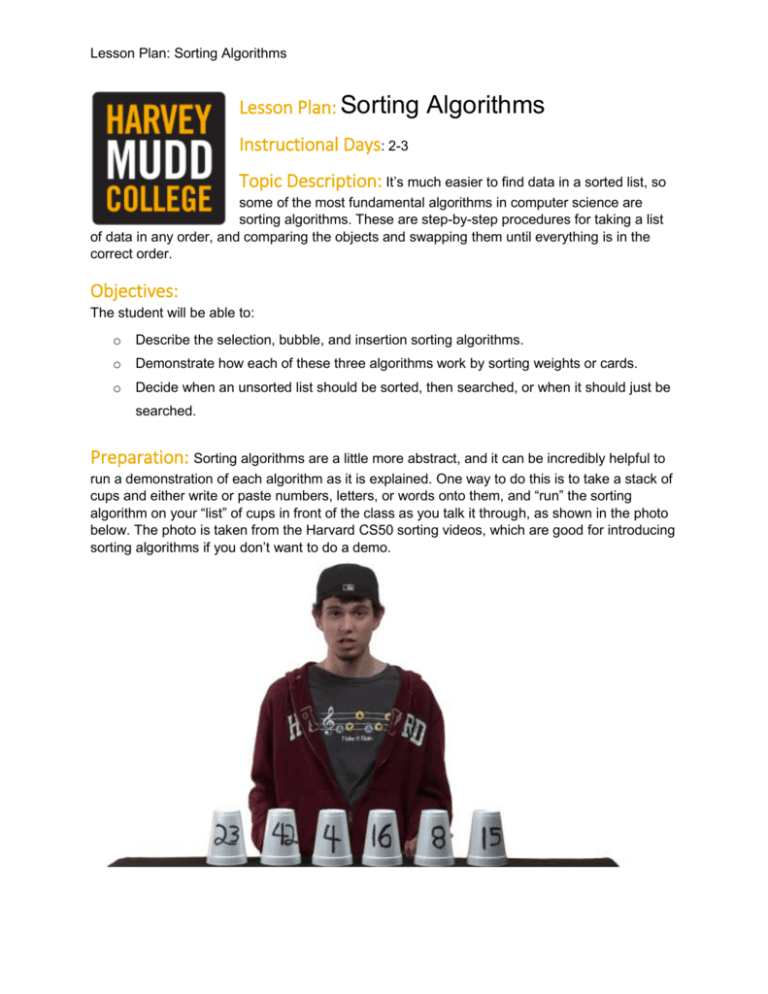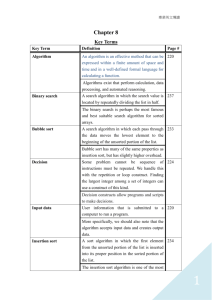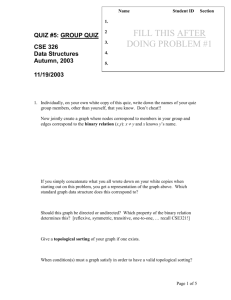Sorting Algorithms L..
advertisement

Lesson Plan: Sorting Algorithms Lesson Plan: Sorting Algorithms Instructional Days: 2-3 Topic Description: It’s much easier to find data in a sorted list, so some of the most fundamental algorithms in computer science are sorting algorithms. These are step-by-step procedures for taking a list of data in any order, and comparing the objects and swapping them until everything is in the correct order. Objectives: The student will be able to: o Describe the selection, bubble, and insertion sorting algorithms. o Demonstrate how each of these three algorithms work by sorting weights or cards. o Decide when an unsorted list should be sorted, then searched, or when it should just be searched. Preparation: Sorting algorithms are a little more abstract, and it can be incredibly helpful to run a demonstration of each algorithm as it is explained. One way to do this is to take a stack of cups and either write or paste numbers, letters, or words onto them, and “run” the sorting algorithm on your “list” of cups in front of the class as you talk it through, as shown in the photo below. The photo is taken from the Harvard CS50 sorting videos, which are good for introducing sorting algorithms if you don’t want to do a demo. Lesson Plan: Sorting Algorithms Sorting algorithms can be tricky because humans often sort by comparing multiple or all objects at the same time. We can also make many swaps at the same time if we know where the objects are supposed to go. However, computers can only compare two objects at a time, and cannot “see” the rest of the list. As you demonstrate, make sure you emphasize that you can only “look at” or “swap” two elements at a time. Once the students have seen the algorithm run once or twice, they can help you walk through the sorting process by telling you what step to take. Then, the students might be ready to practice the algorithm on their own with the card-sorting activity, in which they’ll use the same color and food cards as the binary search activity. Outline of the Lesson: o Discussion: Why Do We Need Sorting Algorithms? o Introduce card-sorting activity o Ask the students to partner up, pick roles, and rank either food or color cards. o Once the class is done, ask a few students to share how they came up with rankings for their cards. Did they compare the cards two at a time? Did they look for their first favorite, then their second favorite, and so on? Mention that ranking and sorting are really the same: they’re taking a collection of objects and putting them in order according to some kind of value. In this case, the value is how much they like the color or food. Did everyone use the same methods to sort? Would their methods work for everyone? o Introduce sorting algorithms o Explain that there are lots of different ways they could have sorted the cards. o Computer scientists make sorting algorithms so that they can sort any unsorted list, no matter what the original order was, and no matter how long the list is. As long as it’s a list, they’d be able to sort it. These algorithms must work for any sorting problem! o Computers and humans don’t quite sort in the same way: Computers can only look at two things at a time. When they “look”, they can see the values and compare the values. When a computer isn’t actively looking at two objects, it doesn’t know what they are. Humans can be trying to decide if they like broccoli or bananas better but also remember that they need to decide where soup and pizza go in their rankings. A computer would only be able to know Lesson Plan: Sorting Algorithms that they were asking “do you like broccoli more than bananas?” and got the answer “yes” or “no.” o Selection Sort o Explain what Selection Sort is and walk the students through the gif animation of numbers being sorted. o Watch the Selection Sort cup demonstration up to 5:30; the pseudocode portion of the video is optional. o Debrief the cup demonstration and make sure the students really understood it. It might be helpful to have your own cup to run additional demonstrations. o Explain and watch “Selection Sort Illustrated” o Have the students define selection sort and ask them to explain how the algorithm works. Once the class seems to have a good grasp of the concepts, they can try to use selection sort to sort their cards. It may be helpful to ask someone to explain how they sorted the cards or to demonstrate it in front of the class so that you can check that they’re doing it correctly. o Bubble Sort o Explain what Bubble Sort is and walk the students through the gif animation of the numbers being sorted. o Watch the Bubble Sort cup demonstration. o Debrief the cup demonstration and make sure the students really understood it. It might be helpful to have your own cups to run additional demonstrations. o Explain and Watch the LEGO bubble sort video and the “Bubble Sort Illustrated” videos o Have the students define selection sort and ask them to explain how the algorithm works. Once the class seems to have a good grasp of the concepts, they can try to use selection sort to sort their cards. It may be helpful to ask someone to explain how they sorted the cards or to demonstrate it in front of the class so that you can check that they’re doing it correctly. o Insertion Sort o Explain what Insertion Sort is and walk the students through the gif animation of the numbers being sorted. o Watch the Insertion Sort cup demonstration until 4:40. The rest of the video expresses the algorithm in terms of pseudocode and is optional. Lesson Plan: Sorting Algorithms o Debrief the cup demonstration and make sure the students really understood it. It might be helpful to have your own cups to run additional demonstrations. o Explain and Watch the “Insertion Sort Illustrated” video o Have the students define selection sort and ask them to explain how the algorithm works. Once the class seems to have a good grasp of the concepts, they can try to use selection sort to sort their cards. It may be helpful to ask someone to explain how they sorted the cards or to demonstrate it in front of the class so that you can check that they’re doing it correctly. o Discussion: Searching & Sorting Wrap-Up o Optional: Watch “Obama Answers a Sorting Question!” o Searching and sorting sometimes go hand-in-hand. Searching becomes a lot easier when things are sorted! But sorting takes a long time and can be tedious. When is it worth it to sort before searching, and when is it worth it to just search? o Bonus: Sorting in Scratch o It can be helpful to see searching and sorting algorithms applied in a computer program. There are lots of algorithm demonstrations in Scratch, and the students can explore them on their own time to solidify their understanding of how these algorithms work. It may be helpful to have a debrief after this activity so students can share what they found and what they learned.





